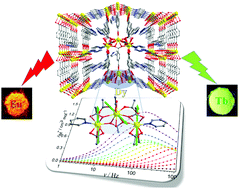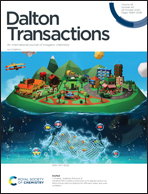A series of lanthanide(iii) metal–organic frameworks derived from a pyridyl-dicarboxylate ligand: single-molecule magnet behaviour and luminescence properties†
Abstract
The reactions of LnIII ions with a versatile pyridyl-decorated dicarboxylic acid ligand lead to the formation of a series of novel three-dimensional (3D) Ln-MOFs, [Ln3(pta)4(Hpta)(H2O)]·xH2O (Ln = Dy (1), Eu (2), Gd (3), Tb (4), H2pta = 2-(4-pyridyl)-terephthalic acid, x = 6 for 1, 2.5 for 2, 1.5 for 3 and 2 for 4). The Ln3+ ions act as nine-coordinated muffin spheres, linking to each other to generate trinuclear {Ln3(OOC)6N2} SBUs, which are further extended to be interesting 3D topological architectures. To the best of our knowledge, the Dy-MOF exhibits zero-field single-molecule magnet (SMM) behaviour with the largest effective energy barrier among the previously reported 3D MOF-based Dy-SMMs. The combined analyses of a diluted sample (1@Y) and ab initio calculations demonstrate that the thermally assisted slow relaxation is mainly attributed to the single-ion magnetism. Furthermore, fluorescence measurements reveal that H2pta can sensitize EuIII and TbIII characteristic luminescence.



 Please wait while we load your content...
Please wait while we load your content...